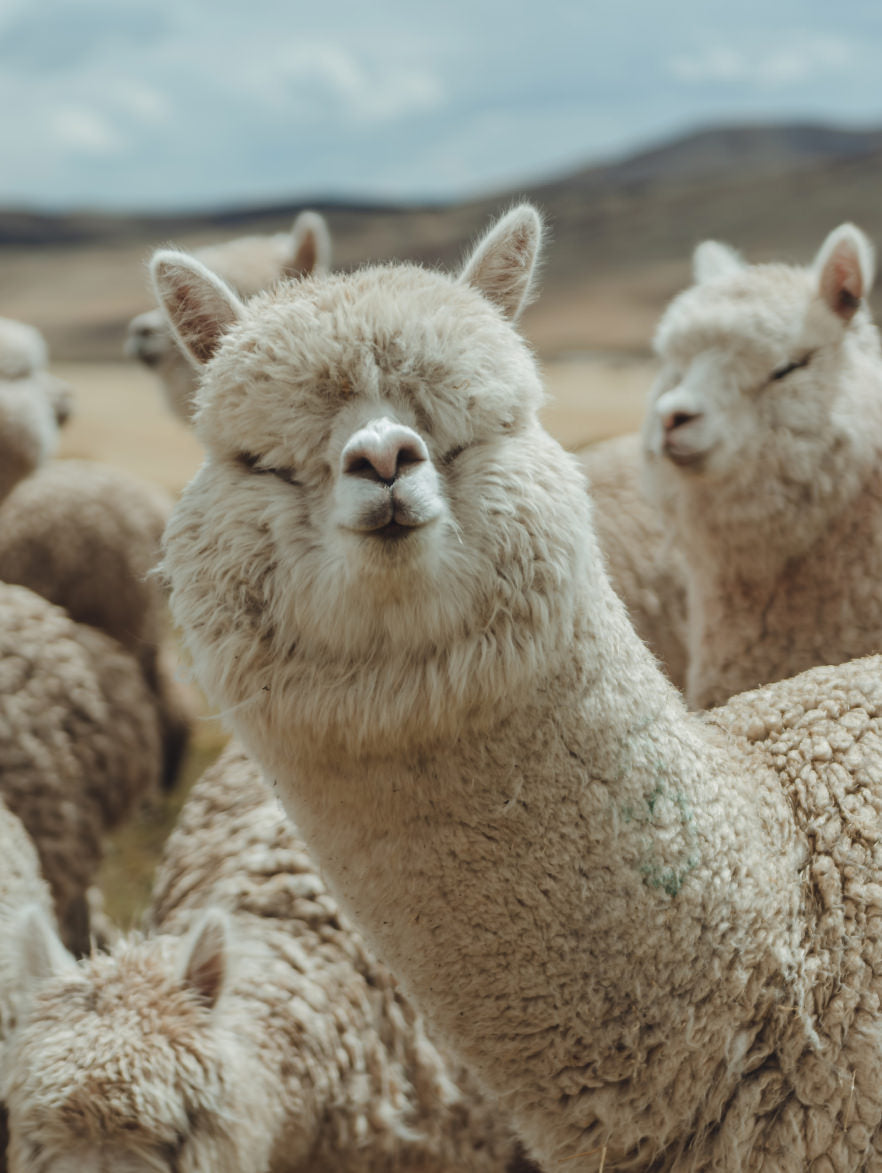



The latest fashion trend isn’t a crazy pattern, cozy pullover or the latest Paris runway piece you saw online—it’s sustainability. Scroll the websites of the biggest names in fashion and there’s a good chance you’ll spot such words as “organic,” “sustainable,” and “green.” While it’s true that brands large and small are developing new styles with planet-friendly production in mind, the fashion industry still ranks near the top when it comes to environmental harm. But even as these titans of industry find new and novel ways to reduce their impact, there's a fiber that’s been around for thousands of years capable of creating long-term change. And it comes from none other than the alpaca.
The benefits of alpaca fiber are aplenty. It manages moisture to keep you cool in hot temperatures and warm in the cold, it’s naturally odor-resistant, and it provides warmth even when it’s wet. Heck, it just might be the greenest natural fiber the world has ever seen! But to better understand the sustainable benefits of alpaca, we need to take a closer look at the animal, the environment, and the clothing in your very own closet.




First, A Word On Sustainability
Before we can really discuss alpacas (don’t worry, we’ll get to them shortly), we need to take a quick detour to discuss sustainability. There’s a good chance you’ve become desensitized to the term “sustainability” in recent years because, truth be told, it’s everywhere. From the plastic bottle that's now made with less plastic to the recycled cardboard box delivered to your door, a lot of today’s products claim to be sustainable. But even though we’ve found it difficult to define the term in a manner that everyone can agree upon, we can say with certainty that sustainability consists of fulfilling the needs of today’s world without compromising our future needs. In other words, we need to co-exist over a long period of time.
Of course, there are countless ways we can blend sustainable practices with our modern world, but how we do so in the apparel industry has long presented a challenge as we choose between synthetic and natural fibers.




Synthetic And Natural Fibers
From shirts to jackets to pants and socks, every piece of clothing you own is made from either a synthetic or natural fiber. Today, 2/3 of all textile items (including those beyond your clothes) are synthetic, but polyester stands out as the most dominant synthetic fiber of the bunch for a number of unique reasons. It’s strong and lightweight, quick to dry, stain resistant and it maintains its shape wash after wash. But it’s also made with petroleum, and creating just one shirt requires large quantities of water, chemicals, and fossil fuels. As you wash it, that same shirt sheds microplastics into the water supply that enter our rivers, lakes, and oceans, some of which winds up in us humans. Once you finally decide to retire your shirt to the trash, it sits in a landfill for decades (if not centuries).
Natural fibers, on the other hand, are a bit less destructive. Like polyester, they’re strong and lightweight, quick to dry, stain resistant and odor resistant too. But textile fibers made with natural fibers are also biodegradable, renewable, and they require far less energy to create. And yet, even popular natural fibers like cashmere and wool don’t quite measure up to alpaca.
Is Alpaca Fiber Sustainable?
In short, yes. Centuries ago, tribes of the Andean highlands domesticated the vicuña, the alpaca’s long-last ancestor. As herds of alpaca roamed the land, the tribes evolved alongside the gentle animals, shearing them annually before releasing them back into their natural habitat where they roamed freely, and the fiber was used to make all manner of goods. In many ways, much of that process remains unchanged.
Unlike synthetic fibers, alpaca fiber is still harvested without the use of chemicals or pesticides. From shearing to wearing, the fabric can be created by hand—it only needs to be sorted, spun into yarn, dyed (if you need a pop of color), and knit or woven into a garment. Unlike cashmere or wool, alpaca doesn’t contain a waxy substance known as lanolin, so it doesn’t need to be treated to remove the lanolin before it’s spun into yarn. Once it turns into, say, your favorite shirt, it rarely needs to be washed because again, the fiber’s antimicrobial and moisture-wicking properties reduce the need for endless wash/dry cycles. And after your alpaca threads reach the end of their life cycle, the natural fibers that enter the environment break down in one to five years. While it may offer benefits similar to that of other natural fibers, we’d wager that it’s a little better than the rest.
Alpacas roam free in their natural habitats supporting biodiversity.




Alpacas roam free in their natural habitats supporting biodiversity.


Are Alpacas Good For The Environment?
Okay, so alpaca fiber is surprisingly sustainable, but what about the animal itself? As you may have guessed, the alpaca has a healthy relationship with the environment, though the reasoning might surprise you. Compared to the two other natural fibers that are most often associated with alpaca (cashmere and merino wool), the alpaca has evolved in many ways that suit its habitat.
For starters, its feet are actually paws that barely leave a footprint, while goats and sheep have sharp hooves that damage soil and further desertification. Alpacas also nibble on the tops of grasses and other plants which promotes regenerative agriculture—goats and sheep, on the other hand, rip vegetation out by the root, disturbing the landscape. They require far less food and water than goats and sheep, yet they produce more fiber with each shear—it takes four goats to make one cashmere sweater, while one alpaca shearing yields four to five sweaters. And even when the time comes to do their duty, alpacas have a communal dung pile that’s located far away from the grass they eat and the water they drink. Their waste is also used as a fertilizer.




Why Sustainable Fibers Are So Important
Sustainable fibers aren’t just better for your personal health or the planet—they take into account the entire supply chain and life cycle of a garment, from where and how it’s made to what happens when it ends up in a landfill. As we think about how our clothing affects the environment, we also think more about the lifecycle of a garment, and why it’s important to invest in clothes that last longer. As we come to terms with the fact that traditional garment dyes are toxic and nearly 80% of Americans have microplastics in their body, it’s essential that we work with transparency to better understand what’s in clothing, just as we use nutrition labels to better understand what’s in our foot. We have the science to prove that natural fibers are better for the planet. Now we need to use that knowledge to create lasting change.

Putting An End To Fast Fashion
More stories like this

Join the herd.
We grant our community private access to new products and exclusive offers.





